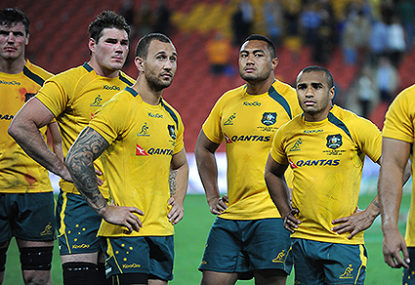Last Saturday’s Bledisloe Cup Test barely registered a blip on the radar of Australia’s sporting conscience.
The proverbial “dead rubber” was played in Dunedin’s magnificent indoor stadium and provided seven tries, classic running rugby and drama, at least for those who bothered to watch.
As both Malcolm Knox and Spiro Zavos pointed out prior to Saturday’s Test, Wallaby games have become far less special.
Another week, another Test. If it’s Saturday, it must be the Springboks.
Not long ago Bledisloe Cup tickets were a “sell your own grandmother” proposition. This year’s Sydney Test had 15,000 empty seats.
Contrast this with June’s British and Irish Lions tour. That was an event.
Three high intensity Tests played amid a proper tour of the provincial teams and a huge fanatical Lions supporter troop.
The fact that Lions’ tours are a once every 12 years occasion helps build the anticipation and the feeling that this is indeed, something special.
We can not have the Bledisloe once a decade or less, but a happy medium needs to be found.
Since the professional era began in 1996, the Bledisloe Cup has been contested 47 times.
That’s a bus timetable-not a rivalry.
The 2000 Bledisloe in Sydney (known collectively as “the greatest Test ever played) drew 110, 000 and Jonah Lomu’s final try in the 39-35 epic is etched in every rugby follower’s mind.
It is no coincidence that around the same time rugby league was crawling out of its own self-inflicted Super League mire.
This period is the genesis for today’s morass.
During the late ‘90s and early 00s there was genuine debate about which rugby code was the strongest.
League had shot itself in the foot and rugby officials saw their main point of differentiation as being the international game.
While league was fighting for the suburbs of Sydney, rugby players were racking up frequent flyer points from Buenos Aires to Biarritz.
Play rugby and see the world; play league and see Wigan.
The plan to cash in on rugby’s advantage was to schedule as much international competition as possible. The Tri-Nations was born, the Super 10 became 12, the 14, then 15 and is marching ominously onto 16, 18 and beyond.
The 2003 Rugby World Cup played in Australia was rugby’s zenith.
Consider these numbers in light of the current state of Australian rugby. 35,000 attended Ireland versus Namibia (yes Namibia) at the SFS.
France versus Scotland in a round-robin pool game drew 79,000 to the Olympic Stadium.
The sold-out final was watched by a television audience of 4.5 million, still the second largest TV audience in Australian history, which culminated in Jonny Bloody Wilkinson’s bloody drop goal.
Last Saturday the Bledisloe drew a national audience of 287,000, a staggering 133,000 behind “Gardening Australia”.
Like a seafood buffet or chocolate cake too much did become, more than enough.
Those special event All Blacks Tests were now rolling around three and in some cases four times a season.
The once mighty Wales, Scotland and Ireland were flown in for a two week, two Test entrée. The concept of the ‘warm-up Test’ was born.
Of course a hectic playing and travel schedule takes a huge toll on the games bets asset, its players.
The Super Rugby season starts early February, after a month of pre-season training and games.
In their unlikely march to this year’s final, the Brumbies accrued over 40,000 kilometres of air travel in three weeks.
The Wallaby‘s northern hemisphere tour ends the first weekend of December.
As the rugby season oozes into its ninth and tenth months it is no surprise that exhausted players are carrying injuries. Attrition leads to a Wallaby squad of third and fourth preferences in the pecking order.
I do not envy Fox Sports and Channel Ten trying to generate interest in an injury-riddled and quality-diluted Wallaby squad playing even more Tests in the wee small hours.
The elephant in the room is, of course, winning.
A successful, Wallaby team generates its own public interest and momentum. A 2013 winning percentage of 30% is not helping.
In a mistaken belief that international quantity can replace quality, the ARU have devalued their own product.
The golden egg laid by the goose of international competition has been boiled, fried, poached, scrambled and broken.
A shorter season and a return to the primacy of Test rugby is needed before the players, rugby followers and the general public are worn out.






























































































